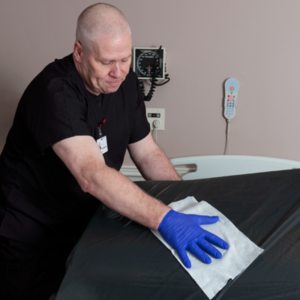Interventional Care


We notice that you are visiting us from . This site only services US-based visitors. Would you like to visit the site that is appropriate for your location?

Decision-making in healthcare typically benefits from a multi-disciplinary approach. The expertise and considerations presented during a decision-making process by those with different perspectives and backgrounds provide insights that may not otherwise be shared. The partnership between infection prevention and environmental services, including representatives from leadership and frontline staff, ensures that issues and concerns with products and processes are effectively addressed so that when implementation occurs there is a healthy understanding of the “why” accompanying the change.
Both IP and EVS, along with facility leadership and frontline staff, need to assess the benefits of adding UVC technology to their environmental disinfection processes. Anderson, et al., discuss the considerations of UVC technology implementation which extends beyond just the IP and EVS partnership to also include bed management1. This is a critical inclusion in the efficiency of implementing a layered approach (standard disinfection with UVC technology supplement) within a facility. Bed management administrators round out the trifecta of prioritizing which rooms receive the layered approach for disinfection1 (this, of course, is based on facility policy and usually includes contact isolation rooms). CAD technology consideration is a conversation that should include IP and EVS prior to implementation due to nuances of use. IP and EVS need to work together to identify areas of the hospital that are frequently overlooked during surface disinfection processes, and/or areas that are frequently re-contaminated after disinfection.

In addition to product selection, the partnership between EVS and IP is also critical to successful practice with compelling support found in the literature. An interesting poster abstract by Stout, et al., discusses the development of an IP and EVS guidebook to maintain the healthcare environment and prevent the spread of microorganisms2. This guidebook is comprehensive, covering multiple topics such as best practices and ongoing quality assurance initiatives in a standardized manner with the additional benefit of enhancing survey readiness. Both electronic and hard copy formats are available for continuous education and new hire orientation2. Brown, et al., studied the impacts of the IP and EVS partnership on the incidence of Clostridioides difficile (CDI)3. EVS staff was educated regarding the importance of their role in the disinfection process and a quantitative performance measure (fluorescent marker) was implemented during IP audits.
Various high-touch areas within the room were fluorescently marked prior to room cleaning, and results were collegially reviewed with the housekeeper. During the study period, IPs also regularly provided education during EVS meetings and a recognition program with certificates reinforcing optimal performance (achieving a 100% score on the room audit)3. The authors concluded that the partnership of EVS and IP using non-punitive education (i.e., disinfectant contact times) and appropriate supplies (i.e., extra-large bleach wipes) led to improved terminal cleaning and was associated with decreased incidence of CDI 3.
Working together, IP and EVS have the capability to provide support and constructive feedback to their own teams for product selection and to re-enforce practice and drive quality disinfection programs within their facility.